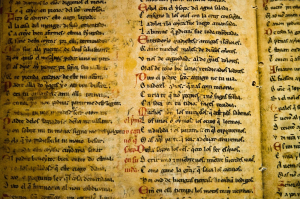Spain. Argentina. Mexico. Colombia. Chile. Does the mere mention of these Spanish-speaking countries leave you daydreaming about your next sabbatical destination? The list goes on and on: there are 21 countries which have Spanish as their official language, so knowing some basic Spanish phrases for your travels can help you communicate with locals and make the most out of your Sabbatical trip. One fascinating thing about the Spanish language is that there are so many different dialects of the language across multiple countries and continents. What may be a recognizable Castilian phrase in northern Spain might be different or pronounced differently in the Andalusian dialect of southern Spain, and different again in the Latin American Spanish spoken in most of Central and South America.
In our series ‘Talk the Talk,’ we cover the basic phrases you will need to be able to speak when traveling to Spain or another country. We’ve laid out some fundamental Spanish words and phrases (mainly in Castilian Spanish) along with the phonetic pronunciation to get you started or to serve as a refresher.
Common Spanish Phrases For Travel
1. How to Say Yes in Spanish
“Yes” in Spanish is: Sì
“Yes” in Spanish is pronounced: See
2. How to Say No in Spanish
“No” in Spanish is: No
“No” in Spanish is pronounced: Noh
3. How to Say Why in Spanish
“Why” in Spanish is: ¿Por qué?
“Why” in Spanish is pronounced: Por-ke
4. How to Say Me in Spanish
“Me” in Spanish is: Yo
“Me” in Spanish is pronounced: Yoh
5. How to Say You in Spanish
“You” in Spanish is: Tú
“You” in Spanish is pronounced: Too
6. How to Say How are You in Spanish
“How are you” in Spanish is: ¿Cómo está?
“How are you” in Spanish is pronounced: Koh-moh es-tah
7. How to Say Yes Please in Spanish
“Yes please” in Spanish is: Sì, por favor
“Yes please” in Spanish is pronounced: See, por fah-vor
8. How to Say No Thank you in Spanish
“No thank you” in Spanish is: No, gracias
“No thank you” in Spanish is pronounced: Noh, grah-thyas
9. How to Say Good in Spanish
“Good” in Spanish is: Bueno (masculine), buena (feminine)
“Good” in Spanish is pronounced: Bwe-noh, bwe-nah
10. How to Say Friend in Spanish
“Friend” in Spanish is: Amigo (masculine), Amiga (feminine)
“Friend” in Spanish is pronounced: Ah-mee-go, ah-mee-ga
11. How to Say What is Your Name in Spanish
“What is your name” in Spanish is: ¿Cómo te llamas?
“What is your name” in Spanish is pronounced: Koh-moh te yah-mahs
Spanish Greeting/Farewell Phrases
12. How to Say Hello in Spanish
“Hello” in Spanish is: Hola
“Hello” in Spanish is pronounced: Oh-lah
13. How to Say Good Morning in Spanish
“Good Morning” in Spanish is: Buenos días
“Good Morning” in Spanish is pronounced: Bweh-nos dee-as
14. How to Say Good Afternoon in Spanish
“Good afternoon” in Spanish is: Buenas tardes
“Good afternoon” in Spanish is pronounced: Bweh-nas tar-des
15. How to Say Good Evening/Goodnight in Spanish
“Good Evening” in Spanish is: Buenas noches
“Good Evening” in Spanish is pronounced: Bweh-nas no-ches
16. How to Say Goodbye in Spanish
“Goodbye” in Spanish is: Adiós
“Goodbye” in Spanish is pronounced: Ah-dyos
17. How to Say See You Later in Spanish
“See you later” in Spanish is: Nos vemos más tarde
“See you later” in Spanish is pronounced: Nos veh-mos mas tah-rde
18. How to Say See You Soon in Spanish
“See you soon” in Spanish is: Te veo pronto
“See you soon” in Spanish is pronounced: Teh ve-oh proh-ntoh
Spanish Etiquette Phrases
19. How to Say Excuse me in Spanish
“Excuse me” in Spanish is: Perdon
“Excuse me” in Spanish is pronounced: Per-dohn
20. How to Say No Problem in Spanish
“No Problem” in Spanish is: No te preocupes
“No Problem” in Spanish is pronounced: No to pre-oh-koo-pes
21. How to Say You’re Welcome in Spanish
“You’re welcome” in Spanish is: De nada
“You’re welcome” in Spanish is pronounced: De na-dah
22. How to Say Bless You in Spanish
“Bless you” in Spanish is: Salud
“Bless you” in Spanish is pronounced: Sa-lood
23. How to Say Have a Good Day in Spanish
“Have a good day” in Spanish is: Que tengas buen dia
“Have a good day” in Spanish is pronounced: Kye ten-gahs boo-en di-ah
24. How to Say Nice to Meet You in Spanish
“Nice to meet you” in Spanish is: Mucho gusto
“Nice to meet you” in Spanish is pronounced: Moo-choh goo-stoh
Basic Spanish Phrases To Help You Get Around
25. How to Say Do you Speak English in Spanish
“Do you speak English” in Spanish is: ¿Habla usted inglés?
“Do you speak English” in Spanish is pronounced: Ah-blah oo-steth een-gles?
26. How to Say Can you Help Me in Spanish
“Can you help me” in Spanish is: ¿Puede ayudarme?
“Can you help me” in Spanish pronounced: Pweh-deh ah-yoo-dar-meh
27. How to Say Where is in Spanish
“Where is” in Spanish is: ¿Dónde está?
“Where is” in Spanish is pronounced: Don-deh es-tah
28. How to Say How Much in Spanish
“How much” in Spanish is: ¿Cuánto cuesta?
“How much” in Spanish is pronounced: Kwan-toh kwes-tah
29. How to Say What is That in Spanish
“What is that” in Spanish is: Que es eso
“What is that” in Spanish is pronounced: Keh es eh-so
30. How to Say I Don’t Understand in Spanish
“I don’t understand” in Spanish is: No entiendo
“I don’t understand” in Spanish is pronounced: Noh en-tyehn-doh
31. How to Say “How do you say ___ in Spanish”
“How do you say ___ in Spanish” is: Como se dice ___ en español
“How do you say ___ in Spanish” is pronounced: Koh-moh seh dee-seh ___ en eh-spahn-yol
32. How to Say Could You Repeat That Please in Spanish
“Could you repeat that please” in Spanish is: Podrías repetir eso por favor
“Could you repeat that please” in Spanish is pronounced: Poh-drias re-pe-tir eh-so por fah-vor
33. How to Say Just a Moment in Spanish
“Just a moment” in Spanish is: Un momento
“Just a moment” in Spanish is pronounced: Oon moh-men-toh
34. How to Say It Hurts Here in Spanish
“It hurts here” in Spanish is: Me duele aquí
“It hurts here” in Spanish is pronounced: Me dweh-leh ah-ki
35. How to Say “I’m Sorry to Bother You, But” in Spanish
“I’m sorry to bother you, but” in Spanish is: Siento molestarte, pero
“I’m sorry to bother you, but” in Spanish is pronounced: Si-ento mo-le-sta-rteh, peh-ro
36. How to Say Where is the Closest Supermarket in Spanish
“Where is the closest supermarket” in Spanish is: ¿Dónde está el supermercado más cercano?
“Where is the closest supermarket” in Spanish is pronounced: Doh-nde es-tah el super-mer-cado mas ser-ka-noh
Spanish Housing-Related Phrases
37. How to Say Do You Have an Extra Key in Spanish
“Do you have an extra key” in Spanish is: ¿Tienes una llave extra?
“Do you have an extra key” in Spanish is pronounced: Ti-eh-nes una ya-veh extra
38. How to Say Are Utilities Included in Spanish
“Are utilities included” in Spanish is: ¿Se incluye el pago del gas, el agua, y la luz?
“Are utility rates included” in Spanish is pronounced: Seh in-klu-ye el pa-goh del gas, el a-gwa, ee la-looz
39. How to Say How Much Does the Connection to the Internet Cost in Spanish
“How much does the connection to the Internet cost” in Spanish is: ¿Cuánto cuesta la conexión a Internet?
“How much does the connection to the Internet cost” in Spanish is pronounced: Kwan-toh kwes-tah la koh-ne-xion a Internet
40. How to Say Is There Something I Should Know About the Neighborhood in Spanish
“Is there something I should know about the neighborhood” in Spanish is: ¿Hay algo que debería saber sobre el vecindario?
“Is there something I should know about the neighborhood” in Spanish is pronounced: Ay al-goh keh deh-beh-ria sah-ber soh-breh el veh-thin-dah-rio
History of the Spanish Language
Did you know that Spanish is predicted to be spoken by 900 million people worldwide by the year 2050? That is about one-eighth of our planet’s population. Spanish is currently the second most widely spoken language in the world, so getting started with some of the basic words and phrases can help you get ahead of the game. Being aware of some of the key history of the Spanish language is also important, and help you in understanding the culture of the Spanish speaking country that you are visiting during your sabbatical.
History of the Spanish Language: The Birth and Latin Influence on Spanish Grammar
 Spanish is the first language of 390 million people and the official language of 21 countries; but how did the Spanish language originate and spread across such distant lands? Let’s begin by talking about the mother of Spanish: Latin. Latin was the language of the Iberian peninsula in the time that the Romans ruled European land during the 1st century.
Spanish is the first language of 390 million people and the official language of 21 countries; but how did the Spanish language originate and spread across such distant lands? Let’s begin by talking about the mother of Spanish: Latin. Latin was the language of the Iberian peninsula in the time that the Romans ruled European land during the 1st century.
After the fall of the Roman empire during the 5th century, different dialects of Latin began to evolve. Spanish was one of these dialects, which as a group came to be known as the five universal “romance languages.” The term “romance language” literally translates to “Romanica loqui,” meaning in a “Roman fashion,” not necessarily that the languages are romantic! These Romance languages include Spanish, French, Portuguese, Italian, and Romanian.
Now that we have discussed a little bit about how the Spanish language originated and really came into existence, let’s talk about the more direct Latin influence. Spanish derives most of its rules of grammar and syntax from Latin. As a matter of fact, approximately 75% of Spanish words are derived from Latin. The Spanish alphabet incorporates the 26 letters of the basic Latin script.
History of the Spanish Language: Arabic Influence
Latin has had a profound influence on Spanish; however, the Spanish language was also greatly influenced by the Arabic language. Did you know that approximately 4000 words in the Spanish dictionary come from Arabic? This phenomenon is explained by the Moors invasion of Spain during the 700 AD.
The 4000 Spanish words that are influenced by Arabic are particularly in the fields of science, technology, agriculture, and trade, and also include many place names. This influence that the Moors had on the Spanish languages contributes to Spanish being rich in linguistic elements from the Arabic languages and explains its wider lexicon, in comparison to the other four Romance languages previously mentioned.
The Arabic influence in the Spanish language is mostly noticeable in nouns, such as place names and surnames versus in Spanish adjectives or verbs. What is particularly interesting about the Spanish language is the existence of word pairs, derived from both Latin and Arabic. What this means, is that there are pairs of words that sound completely different (one originating from Latin and the other one from Arabic), but have the exact same definition. An example of this is the word pair for the word migraine- “migraña” and “jaqueca.”
History of the Spanish Language: The Spread of Spanish Across the Western World
How exactly did Spanish spread across such vast distances? The answer is Christopher Columbus. After 700 years of power struggles, King Alfonzo the 10th deemed that Castilian (a formal dialect of Spanish) would be the language that was to be used for all official Spanish documents. That is how Spanish became the official language of Spain.
When Christopher Columbus sailed across the Atlantic ocean from Spain in 1492, his “discovery” of the West by Europeans led to the mingling of Spanish with the languages of Mexico, the Americas, and the Caribbean. Each country gave Castilian twists that still exist today; however, the linguistic language traffic was not all one-sided. Both Spanish and the foreign languages of the West influenced each other, as Spanish borrowed from native languages as well. To be more specific, Spanish borrowed words for things that did not exist in their “old world.”
And today, with over 400 million native speakers in 21 countries, Spanish truly is a world language. After Mandarin Chinese, Spanish is the second most spoken language on the planet. Make your sabbatical and travel to any Spanish-speaking country as smooth as possible with our 40 Basic Spanish Phrases for Travel!
Related: Taking a Sabbatical? What You Need to Know
Learn basic phrases in a foreign language to help ease traveling to another country. Let us know what you think! Connect with us on Twitter, LinkedIn, Facebook, Instagram, YouTube and Pinterest.






Like to learn spanish